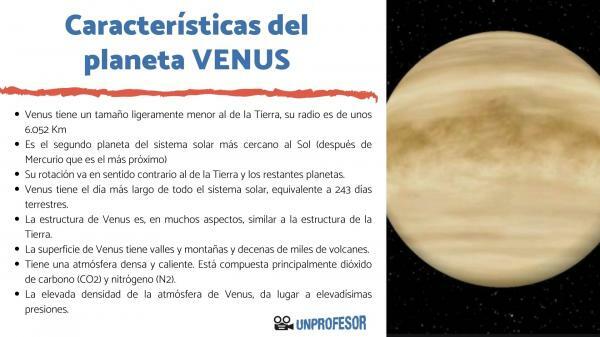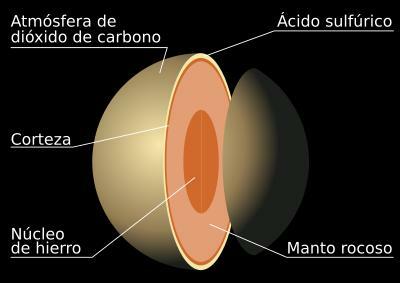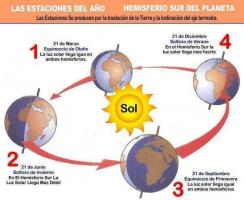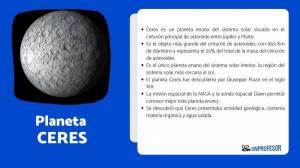Characteristics of the PLANETA VENUS

Venus is an amazing planet For many reasons, and although it is similar to Earth in some ways, it is an inhospitable place where conditions are extreme. Unmanned spacecraft that have landed on its surface can only send data for a short period of time before being destroyed by high temperatures and high surface pressures of Venus.
In this lesson from a TEACHER you will discover the venus characteristics, what is hidden under its dense atmosphere and what makes it different from the other planets in the solar system.
Venus is a terrestrial planet just like Mercury, Earth and Mars; are all of them planets of the solar system interior, that is, lThe planets closest to the Sun. It is therefore a solid planet, with characteristics similar to those of planet Earth, in terms of its structure and size.
It is sometimes said that Venus is a twin planet to Earth because in some respects the two planets are very similar. However, in other respects they are very different planets.
Similarities between Venus and Earth
- They are planets close to the Sun, located in the inner solar system.
- It has a rocky, solid and compact surface. And its internal structure is the same as that of the Earth.
- It has an atmosphere, although it is denser and hotter than Earth's.
- The size of Venus is very similar to that of Earth
- Neither Venus nor Earth have rings
Differences between Venus and Earth
- Venus rotates on itself in the opposite direction than most planets in the solar system, including Earth; and besides, it does it very slowly.
- It has no moons.
- It does not have a magnetosphere. Despite having an iron core, like Earth, it does not generate a magnetic field.
- Now that we know the general characteristics of the planet Venus, we will see what this planet is like in more detail in the next section.
We are going to know what are the main characteristics of Venus. Here you are.
Size and distances from the Sun
Venus is slightly smaller in size than Earth, its radius is about 6,052 km and it is the second planet in the solar system closest to the Sun (after Mercury, which is the closest). At a distance of 108 million kilometers.
Rotational and translational movements of Venus
One of the peculiarities of Venus is that its rotation goes in Wrong Way that of the Earth and the other planets of the solar system, with the exception of Uranus which also rotates on itself "backwards". In addition, it is a rotational movement extremely slow.
For this reason, Venus has the longest day in the entire solar system, equivalent to 243 Earth days; even exceeding the length of the year on Venus (the time it takes the planet to complete an orbit around the Sun), which is 225 Earth days. The orbit of venus is practically a perfect circle, unlike the other planets in the solar system, which have more elliptical or oval orbits.
Structure of Venus
The structure of Venus is, in many respects, similar to the structure of the Earth. Have a cast iron core of about 3,200 km of radius. Above the core is a mantle formed a mass of molten rocks in motion due to the heat of the core. Despite the similarities of Venus's structure to that of Earth, an important difference is that, unlike Earth, Venus does not exhibit geomagnetism.
The surface of the planet is made up of a fine solid rock crust that floats on top of the mantle, and that presents a high volcanic activity.
Venus surface
The surface of Venus has valleys and mountains and tens of thousands of volcanoes. The highest mountain on Venus is Mount Maxwell, which is 8,800 m high (similar to the height of Everest, the highest mountain on planet Earth). The surface of Venus is considered to have been completely reshaped due to the high volcanic activity that has taken place on the planet millions of years ago.
In addition, the surface of Venus shows a large number of craters due to the impact of meteorites. They are large craters (between 1.5 and 2 km in diameter). This is because only large meteorites reach the surface of the planet, while smaller ones burn as they pass through the dense atmosphere that surrounds Venus.

To finish knowing the characteristics of the planet Venus, here we are going to talk about its atmosphere. All terrestrial planets have an atmosphere (although Mercury's is not permanent), that is, they are surrounded by a layer of gases that covers their surface. The presence of the atmosphere is related to the size, the mass, the temperature, the formation process of the planet and if there is presence of life in them.
In the case of Venus, it is a hot and dense atmosphere. It is composed mainly of carbon dioxide (CO2) and nitrogen (N2). It is a permanently foggy atmosphere, due to the constant presence of yellowish clouds composed of sulfuric acid (H2SO4).
The CO2 and sulfuric acid that make up the atmosphere of Venus are gases that cause greenhouse effect, that is, they trap heat (infrared rays) preventing it from dissipating. For this reason, the atmosphere of Venus is extremely hot, reaching temperatures of 470ºC on the planet's surface. However, the planet's atmosphere is made up of different layers, each of which is at a different temperature. At a distance of about 48 km from its surface, the atmosphere of Venus reaches temperatures similar to those of Earth.
Due to its proximity to the Sun and the characteristics of its atmosphere, it is the hottest planet in the solar system, although it is not the closest to the Sun.
The high density of the atmosphere of Venus, gives rise to very high pressures which are far superior to those of the Earth's atmosphere. The atmosphere of Venus reaches pressures of 93 bars, more than 90 times higher than the Earth's atmosphere, which is equivalent to the pressure we would experience in the ocean at a depth of 1600 m.
The dense clouds formed by droplets of sulfuric acid, which permanently envelop Venus, prevent observation of the planet's surface by telescopes. The data obtained on the characteristics of the surface of the planet Venus, are those that have provided the ships unmanned aircraft that have landed on its surface or images obtained by radar, from artificial satellites orbiting its around.




